|

Warthogs and babirusas:
Pigs with dental
problems!
Have
you heard of warthogs and babirusas? Perhaps not. The names certainly
sound weird, but they are not referring to any fictional or mythical
creatures. They are the names of two unusual, but real creatures from
the animal kingdom.
|
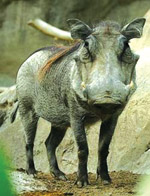
The warthog has four wart-like tusks |
|
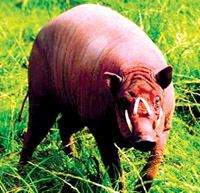
A babirusa with pink coloured skin like a pig’s. |
Even if most of you have never heard of a babirusa, those of you who
have seen the famous Disney movie "Lion King" should be familiar with
the warthog, because Pumba (Simba's friend) is a warthog. So, let's
check out these two odd-looking creatures, both of whom belong to the
pig family.
Known as the 'naked swine of the savanna, the worthog, which is a
wild member of the pig family is found in Africa. The warthog gets its
common name from the four wart-like tusks found on its head.
The tusks, which protrude from its mouth, are curved about 90 degrees
or more, from the root onwards. The upper set of tusks generally grow up
to 9 inches (23 cm) and seem like a squashed circle in cross-section,
almost rectangular.
All four tusks or teeth grow upwards, but the lower teeth are far
shorter than the upper ones. The upper ones are more spectacular in
appearance, however it is the lower ones that are considered dangerous;
they are sharply pointed and straight. The male warthog uses these
tusk-like teeth as weapons when fighting. The lower set can inflict
serious wounds.
|
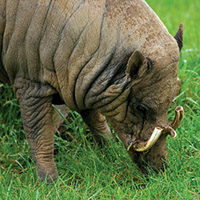
A babirusa with wrinkled skin like a hippo’s |
|
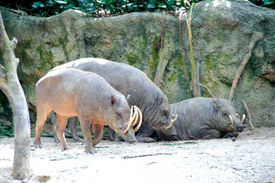
Babirusas live in small groups |
The male warthogs who are not territorial, are larger than the
females. They could weigh between 150-220 pounds while the females will
be in the range of 99 to 150 pounds in weight.
Warthogs come in a variety of colours - light brown to dark brown and
grey to mostly black. The new borns are generally light brown or pinkish
in colour.
In general, warthogs can tolerate higher than normal body temperature
due to their ability to conserve moisture inside the body. They are fast
runners capable of even jumping.
Even though they can fight predators, their primary mode of defence
is fleeing. They do so by sprinting and when they run, they usually do
so with their tails up in the air. Can you guess who the warthog's prime
enemies are? Yes, we humans are in the list among lions, leopards,
crocodiles, hyenas and sometimes cheetahs too.
The warthogs ivory tusks are naturally an attraction for humans who
value ivory highly. You must be well aware how most of our pachyderms
(elephants) are killed purely for their tusks, so much so that elephants
with huge tusks are rare today. Isn't it rather disturbing to think that
we humans, who are considered the superior of all living beings, find
some reason or the other to kill innocent animals?
Well, coming back to warthogs, and their physical attributes,
warthogs are believed to have rather poor eyesight. However, they have a
strong sense of smell, like their cousins, the pigs. They use this
strong sense of smell to detect predators, locate food and recognise
other members of their family.
|
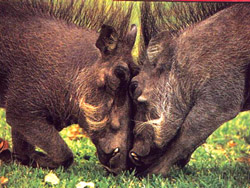
Two warthogs in a duel |
|
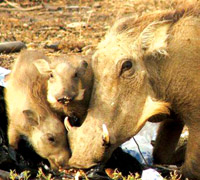
Warthog mum with two babes |
They are diurnal (daytime) animals and sleep in self-excavated
burrows. They are powerful diggers and use both their feet and head (the
tusks) to dig burrows. However, if they come across abandoned or
unoccupied burrows they prefer to use them rather than spend time and
energy digging new ones. One fact that is bound to amuse you is the way
they enter these burrows.
It is said that a warthog will always enter it, backwards, meaning
rear first and not head first. Wondering why it does so? Well, to be
ready for action - to burst out without any delay when necessary. Don't
you think it's clever?
Now let's check out what a warthog's menu consists of. As it's an
omnivorous creature, it certainly has a wide choice - grass, roots,
berries, fruits, bark, fungi, eggs, dead animals which includes small
mammals, reptiles and birds, depending on the availability of food,
during different seasons. They will not hunt other animals for food.
Warthogs prefer to forage (make roving search), for food in dense,
moist areas usually, but they are also found in open grassland. These
creatures like to wallow in mud. As they drink regularly, they visit
water holes very often.
|
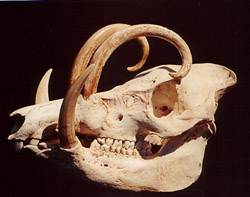
The skull showing how the teeth curve |
|
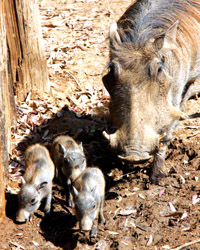
Warthog sow with piglets |
In general, warthogs can be spotted in groups even though males tend
to live apart in small bachelor groups. Did you know that a grouping of
warthogs are called a sounder? The core of the sounder is usually a
female with a few offspring. A sounder can be as small as 3-10 warthogs
or as large as 30 warthogs.
Females give birth to a litter of 2 to 8 piglets (2-4 piglets are
more typical) after a gestation period (time offspring are carried in
the womb), of 5 to 6 months. The piglets are weaned from mother's milk
by the time they reach three or four months.
However, nursing is considered an important interaction between
mother and offspring. Special modes of vocalizations, often 'question
and answer vocalization' are said to take place between mother and
offspring. Warthogs are known to growl when frightened. They are also
famous for ferociously defending their families when threatened.
Now that you know so much about the real-life family members of your
friend Pumba from the movie world, let's move on to find out some
interesting information about another one of its cousins, the babirusa.
Native to Sulawasi and the surrounding islands of Indonesia, it is
most often called the pig-deer due to its pig-like appearance and tusks
that resemble antlers. One of the oldest living members of the pig
family, it is classed as a single species in the genus Babyrousa.
However, some researchers say there could be several species.
Due to its split hooves and three - chambered stomach, the babirusa
was initially thought to be a ruminant. Some claim that the babirusa is
closely related to the hippopotamus (relatives of the pigs themselves).
There are two sub-species in the zoos, one species in the American zoos
and another in the European zoos.
Babirusas have cylindrical shaped bodies (short, stiff haired),
bristly skin, small ears, long snouts and extraordinarily long and thin
legs. They are about a metre long and weigh about a 100 kg.
Special markings distinguish them from other pigs. Babirusas are
unique in the animal kingdom because of the special dental features they
have. And they are special not because of the length or the fact that
they are growing outside of the mouth (like in warthogs).
They are special because the teeth or tusks are growing through the
snout, from inside to the outside. Together with the canine teeth of the
lower jaw, the teeth resemble antlers.
At first glance, the canine teeth of the upper jaw seem useless, but
they do come in handy in combat. Only males have such bizarre teeth. The
females have upper canine teeth which grow to a normal length and meet
between the eyes or no canine teeth at all.
Males use them as symbols of status. The upper teeth pierce the snout
and grow upward, curving back, almost to the point of piercing the skull
between the eyes. The tusks can reach a length of 12.4 inches (31 cm) in
males.
Found mostly in Sulawesi, Togian, Sulu and Buru Islands of Indonesia,
babirusas are the subject of many mythical stories and legends due to
their weird appearance. These omnivorous animals that thrive on small
animals, carrion, grasses, leaves and fruits, live in small groups
comprising 4-5 individuals or sometimes even less.
Males are solitary animals, who like to wallow in mud. When
confronted by an opponent, the males will stand on the hind legs and
box, trying to break the opponent's tusks.
Females give birth generally to a couple of piglets in a nest built
in the underbrush, and nurse them on the single pair of nipples, she has
(Unlike her cousins who have many piglets and many nipples or to
accommodate them.)
The piglets are nursed continuously for 6-8 months even though they
begin to eat solids by the time they are 3-10 days old. Babirusas are
good swimmers and are known to swim long distances, when necessary.
When foraging for food, they move in the same paths worn down by
years of travel. About 35-42 inches in length weighing up to 198 lbs,
the babirusas are indeed a fascinating species of the pig family and
continue to confuse researchers as to which category of animal they
really belong to.
Going by their name in native language babi means pig and rusa means
deer. The appearance too, for example, the long legs similar to a deer,
upper tusks that resemble outlers and wrinkly, hairless skin like that
of the hippopotamus has left many wondering whether the babirusa should
be likened to a deer hippo or pig. |
